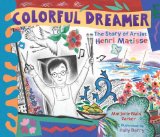Review of Oops Paint, by Kathryn Horn Coneway
by Kathryn Horn Coneway
Mascot Books, Herndon, Virginia, 2013.
The “note for parents, teachers, and other creative companions” at the end of this book tells us that the author wanted to create a book about printing simple enough for toddlers to understand.
She has achieved that objective, and besides creating a book about stamping with everyday objects, “always a favorite activity and a great way to explore shape, texture, and color with young children,” she has also created a simple matching activity with the examples in this book.
Here’s how the book begins:
One day I decided to make a painting. My mom put out my colors – red, blue, and yellow – on a paper plate on the table.
There’s a picture of a paper plate with three little pools of paint on that page. On the facing page, we’ve got painted cat prints on the page.
I went to get my smock. While I was gone, someone curious jumped up on the table.
Oops! When I came back I found this painting made by my…
[page turn]
Cat.
And so it continues. Next, his brother runs a toy truck through the paint and we see that result. Then he moves to the floor and his sister runs through the paint.
After the story part is finished, there are three sets of pages which have objects on one side and the prints they make on the other side. Then finally, many objects are stamped together into a picture at the end.
This story has a few rough edges. It would have been nice if the cat prints, for example, look like they were actually made by a cat, or if the cat were shown with painted paws. (Though I realize that may be asking a bit much!) The language is not particularly catchy, and the explanations maybe a little long for toddlers.
However, overall, she has created a wonderful book for introducing printing to toddlers and preschoolers. It will start all sorts of conversations about shapes and colors. And any book for toddlers with “Oops!” on every page has got to be a good one!
Fair warning: You probably shouldn’t read this book to your child unless you’re willing to get messy and try it out yourself!
Find this review on Sonderbooks at: www.sonderbooks.com/Childrens_Nonfiction/oops_paint.html
Disclosure: I am an Amazon Affiliate, and will earn a small percentage if you order a book on Amazon after clicking through from my site.
Source: This review is based on a library book from Fairfax County Public Library.
Disclaimer: I am a professional librarian, but I maintain my website and blogs on my own time. The views expressed are solely my own, and in no way represent the official views of my employer or of any committee or group of which I am part.










